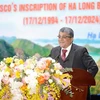While the contemporary arts scene has expanded rapidly in recent years, traditional art forms like tuong (classical drama) are being ignored, cultural experts of Ho Chi Minh City have said.
Speaking at a recent forum hosted by the HCM City Theatre Association, Nguyen Anh Kiet, director of the city's Tuong Theatre, said that only 14 candidates who are members of tuong clubs in southern provinces had applied to take part in the tuong course at this theatre this year.
"Last year, none applied for the course," he said.
Kiet, a tuong actor, said: "Tuong is a particularly difficult art to master. In theatre or film, amateurs can practise a bit and perform, but you cannot perform tuong unless you are properly trained."
"Our two-year course aims to give students a chance to discover and develop their technique, skills and emotional expression on the stage. We are facing a shortage of young, skilled tuong performers," he said.
People's Artist Dinh Bang Phi, who has more than 30 years experience in tuong, agreed with Kiet, saying that "cultural authorities need to invest in producing talented young artists if the art is to truly develop."
Tuong originated in the 12th century in Vietnam, but its growth occurred mainly in the 17th century in the central region. The art consists of dance, song, and music performed by artists skilled in masquerade.
Along with cheo (traditional opera) in the north and cai luong (reformed theatre) in the south, tuong is an integral part of Vietnamese culture.
The art was developed from a folk art into a royal art, and has themes eulogising loyalty to the monarch and patriotic duty.
"To perform, artists use most of their body. If they lack a powerful voice, they cannot sing and dance while also expressing the emotions of each character," theatre director Thanh Hiep, who has researched tuong for several years, said.
"It is an exhausting art because it involves wearing costumes that sometimes weigh up to 10kg," he said.
Hiep said that the lack of audiences is a problem as they are important to the survival of traditional stage arts and classical drama.
"We should encourage and educate a new generation of viewers who understand and like tuong," he said.
Actor Ngoc Khanh of the Ngoc Khanh Tuong Club, said: "To maintain the theatre, we need a bigger number of young and skilled performers."
"Tuong plays are a big challenge for our young staff who perform with poor performance and living skills," she said.
Khanh's club is one of the city's pioneers who have wasted no time waiting for the local government, finding a way to develop and improve its staff of young performers.
"We are working with local museums, hotels and restaurants to provide short tuong shows for their visitors," he said.-VNA
Speaking at a recent forum hosted by the HCM City Theatre Association, Nguyen Anh Kiet, director of the city's Tuong Theatre, said that only 14 candidates who are members of tuong clubs in southern provinces had applied to take part in the tuong course at this theatre this year.
"Last year, none applied for the course," he said.
Kiet, a tuong actor, said: "Tuong is a particularly difficult art to master. In theatre or film, amateurs can practise a bit and perform, but you cannot perform tuong unless you are properly trained."
"Our two-year course aims to give students a chance to discover and develop their technique, skills and emotional expression on the stage. We are facing a shortage of young, skilled tuong performers," he said.
People's Artist Dinh Bang Phi, who has more than 30 years experience in tuong, agreed with Kiet, saying that "cultural authorities need to invest in producing talented young artists if the art is to truly develop."
Tuong originated in the 12th century in Vietnam, but its growth occurred mainly in the 17th century in the central region. The art consists of dance, song, and music performed by artists skilled in masquerade.
Along with cheo (traditional opera) in the north and cai luong (reformed theatre) in the south, tuong is an integral part of Vietnamese culture.
The art was developed from a folk art into a royal art, and has themes eulogising loyalty to the monarch and patriotic duty.
"To perform, artists use most of their body. If they lack a powerful voice, they cannot sing and dance while also expressing the emotions of each character," theatre director Thanh Hiep, who has researched tuong for several years, said.
"It is an exhausting art because it involves wearing costumes that sometimes weigh up to 10kg," he said.
Hiep said that the lack of audiences is a problem as they are important to the survival of traditional stage arts and classical drama.
"We should encourage and educate a new generation of viewers who understand and like tuong," he said.
Actor Ngoc Khanh of the Ngoc Khanh Tuong Club, said: "To maintain the theatre, we need a bigger number of young and skilled performers."
"Tuong plays are a big challenge for our young staff who perform with poor performance and living skills," she said.
Khanh's club is one of the city's pioneers who have wasted no time waiting for the local government, finding a way to develop and improve its staff of young performers.
"We are working with local museums, hotels and restaurants to provide short tuong shows for their visitors," he said.-VNA



















